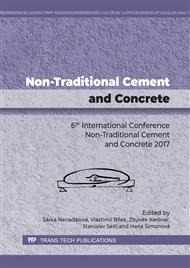[1]
M. G. Stewart, D.V. Rosowsky, Time-dependent reliability of deteriorating reinforced concrete bridge deck, Struct. Saf. 20 (1998) 91-109.
DOI: 10.1016/s0167-4730(97)00021-0
Google Scholar
[2]
P.J. Tikalsky, D. Pustka, P. Marek, Statistical variations in chloride diffusion in concrete bridges, ACI Struct. J. 102 (2005) 481-486.
Google Scholar
[3]
B. Teplý, D. Vořechovská , Reinforcement Corrosion: Limit States, Reliability and Modelling. J. Adv. Conc. Technol. 10 (2012) 353-362.
Google Scholar
[4]
P. Ghosh, P. Konečný, P.J. Tikalsky, SBRA model for corrosion initiation of concrete structures. RILEM Bookseries, 5 (2011) 85-100.
DOI: 10.1007/978-94-007-0677-4_5
Google Scholar
[5]
C. Andrade, Calculation of chloride diffusion coefficients in concrete from ionic migration measurements. Cement Concrete Res. 23 (1993) 724-742.
DOI: 10.1016/0008-8846(93)90023-3
Google Scholar
[6]
W. Morris, E.I. Moreno, A.A. Sagues, Practical evaluation of resistivity of concrete in test cylinders using a Wenner array probe, Cement Concrete Res. 26 (1996) 1779-1787.
DOI: 10.1016/s0008-8846(96)00175-5
Google Scholar
[7]
P. Mangat, B. Molloy, Prediction of long term chloride concentration in concrete. Mater. Struct. 27 (1994) 338–346.
DOI: 10.1007/bf02473426
Google Scholar
[8]
M.D.A. Thomas, P.B. Bamforth, Modelling chloride diffusion in concrete effect of fly ash and slag. Cement Concrete Res. 29 (1999) 487–495.
DOI: 10.1016/s0008-8846(98)00192-6
Google Scholar
[9]
fib Model Code 2010 (2012) fib Bulletins 65 and 66 (and No. 34: Model Code for Service Life Design, 2006).
Google Scholar
[10]
Probabilistic model code: Joined Committee for Structural Safety. On line: http: /www. jcss. byg. dtu. dk/Publications/Probabilistic_Model_Code. aspx.
Google Scholar
[11]
P. Ghosh, Q. Tran, Correlation between Bulk and Surface Resistivity of Concrete, International Journal of Concrete Structures and Materials. 9 (2014) 119-132.
DOI: 10.1007/s40069-014-0094-z
Google Scholar
[12]
Q. Tran, P. Ghosh, P. Konečný, P. Lehner, Determination of Time Dependent Diffusion Coefficient Aging Factor of HPC Mixtures. Key Eng. Mat. (Under review).
DOI: 10.4028/www.scientific.net/kem.832.11
Google Scholar
[13]
X. Lu, Application of the Nernst-Einstein Equation to Concrete, Cement Concrete Res. 27 (1997) 293-302.
DOI: 10.1016/s0008-8846(96)00200-1
Google Scholar


